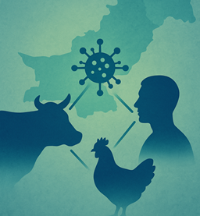Pakistan has recently suffered a number of outbreaks of human and animal adenovirus infections, Pakistani and University of Texas Medical Branch researchers joined forces to investigate the various types of adenoviruses circulating in both people and animals. Their work was recently reported on the preprint server, Research Square
In this report they screened more than 1,700 samples from humans, poultry, and livestock between 2019 and 2021. Among the most surprising finding came from a 22-year-old man with respiratory symptoms who was found to have molecular evidence of bovine adenovirus type 2 (BAdV-2) in his nose. Prior to this detection, such cattle virus had never been detected in a human. Genetic analysis showed a strong similarity to strains previously isolated from cows in Spain and Japan (1). While the detection does not prove the young man was infective, the observation of illness with signs of respiratory disease is suggestive of infection with the cattle virus.
While adenoviruses are typically species-specific, occasional cross-species infections have been documented—though rarely with clear clinical impact (2). This detection adds to a small but growing body of evidence that zoonotic adenovirus spillovers do occur. Prior studies have reported antibodies to canine, simian, and bovine adenoviruses in humans, suggesting past exposure (2). Now, this Pakistani case shows a possible active infection. It's a reminder that zoonotic viruses don’t always arrive with the drama of Ebola or COVID-19 —some creep in quietly (3).

The public health implications of this finding are significant. Environments where humans and animals interact closely—such as live bird markets, mixed-species farms, and backyard poultry operations—are natural hotspots for viral exchange. These spaces offer conditions for viruses to adapt, recombine, and occasionally jump species. As global health experts continue to warn, the next pandemic could easily come from a pathogen we’re not actively watching, or pathogen X.
That’s why this study is more than just academic curiosity. It’s a call to expand and integrate our disease surveillance systems under a One Health approach—recognizing that the health of people, animals, and the environment are deeply interconnected (4). Traditionally, human and veterinary health data are gathered and studied separately, however viruses don’t recognize those divisions. To catch the next zoonotic threat early, we need systems that monitor pathogens across species, share data rapidly, and include genomic tools that can spot unusual or emerging strains. UTMB’s Professor Gregory Gray says “While it is unfeasible to conduct surveillance for novel viruses in every animal species, strategically, it is important to focus such surveillance at human-animal interfaces where large populations of animals are in close contact with humans. Our team is conducting such human, animal, and environmental surveillance (One Health) on livestock farms and at live animal markets.”
The surveillance effort implemented by this study is a powerful proof of concept. It shows that by looking beyond just human patients—and beyond just the usual suspects like influenza and COVID—we can begin to understand the bigger picture of viral ecology and transmission.
The unexpected detection of a cow viral strain in a human airway isn’t just a red flag. It’s a reminder that in the fight against emerging infectious diseases, collaboration and vigilance are our best defenses. One Health isn’t just a slogan—it’s a strategy we can’t afford to ignore any longer.
References:
- Ansari, J., et al. (2025). Molecular Typing of Adenoviruses Associated with Respiratory Illness Among Humans and Poultry, Pakistan. Research Square. https://doi.org/10.21203/rs.3.rs-5811360/v1
- Borkenhagen, L. K., Fieldhouse, J. K., Seto, D., & Gray, G. C. (2019). Are adenoviruses zoonotic? A systematic review of the evidence. Emerging Microbes & Infections, 8(1), 1679–1687. https://doi.org/10.1080/22221751.2019.1661215
- Lynch, J. P. III, & Kajon, A. E. (2021). Adenovirus: Epidemiology, Global Spread of Novel Types, and Approach to Treatment. Seminars in Respiratory and Critical Care Medicine, 42(04), 508–524. https://doi.org/10.1055/s-0041-1731007
- Destoumieux-Garzón, D., et al. (2018). The One Health Concept: 10 Years Old and a Long Road Ahead. Frontiers in Veterinary Science, 5, 14. https://doi.org/10.3389/fvets.2018.00014
